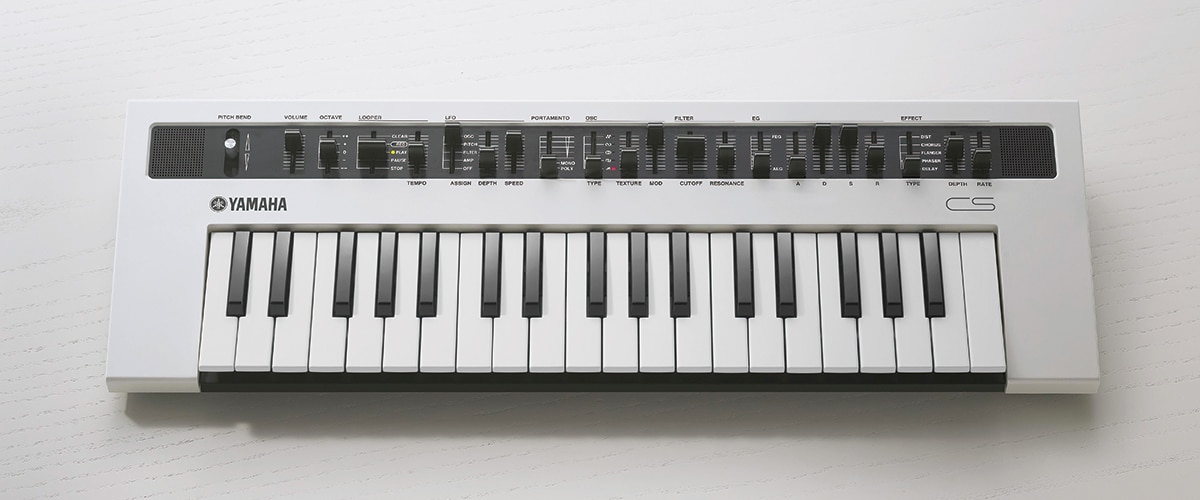reface



![]()
- -8-note polyphonic Virtual Analog synth
- -Five unique oscillator types
- -Powerful and intuitive control

hands-on

reface CS overview
Waves
Multi-saw
Pulse
OSC Sync
Ring Mod
FM
Multi-saw
Multi Saw produces a typical synthesizer sound on the basis of sawtooth waveforms.
The term "Multi" stands for the possibility to layer multiple waveforms.
TEXTURE :
Adds an octave lower Sub-Oscillator
MOD :
Layers multiple sawtooth waveforms for a thicker sound.
Pulse
Produces a basic synthesizer voice by using square waves. Two square waves with different pitches can be layered to make the sound more complex.
TEXTURE :
changes pitch of 2nd square wave
MOD :
change pulse width
OSC Sync
Produces voices having two oscillators (OSC1 and OSC2), with OSC2 locked in sync with OSC1. Intense harmonics can be generated by changing the pitch and tone of OSC2, making it possible to create highly distinctive, dazzling sounds.
TEXTURE :
changes pitch and tone of OSC2
MOD :
sets pitch change amount
Ring Mod
Produces voices by multiplying the signals from two oscillators (OSC1 and OSC2). Metallic-sounding voices with no distinct pitch can be created by changing the pitches of the oscillators.
TEXTURE :
changes pitch of OSC1
MOD :
changes pitch of OSC2
FM
Produces voices having two oscillators (OSC1 and OSC2), with the frequency of OSC1 modulated by OSC2. This makes it possible to create voices with intense harmonics such as those of the Yamaha DX7 and other FM synthesizers.
TEXTURE :
sets Modulation amount
MOD :
changes pitch of the Modulator
Controls
LFO
EG
FILTER
EFFECT
PORTAMENT
LFO
The [DEPTH] and [SPEED] sliders control modulation speed and intensity. In addition to typical LFO uses, you can create interesting sound effects using extreme settings. So if you want get back at your motorcycle-driving neighbors, try out the following example! (Some amplification may be required!)
EG
EG/FEG slider determines how much the Envelope affects Amplitude or Filter. The"zero" position (AEG) means the Envelope only affects Amplitude. Asthe slider is moved upwards, the more influence the Envelope has on the Filter. In the middle position the effect on Filter and Amplitude is the same.
The envelope (EG) is set by the ADSR principle (Attack, Decay, Sustain, Release) with four sliders. Again, the range of values is from 0 to 127.
FILTER
reface CS is equipped with a resonant low-pass Filter (18 db). The Cutoff slider adjusts the Filter from follow closed (0) to wide open (127) while the Resonance slider adds harmonics at the Cutoff point. The filter can even self-oscillate creating different kinds of synth sound.
EFFECT
The onboard effects processor features five effect types to add depth to your sound.
Use the Type slider to select the desired effect. Depth determines the effect's intensity (also known as "Wet/Dry"). The Phaser and Chorus/Flanger are powered by Virtual Circuitry Modeling (VCM) technology.
PORTAMENT
The reface CS Portamento slider has two functions. It controls the typical Portamento effect: switching reface to 8-note polyphonic to 1-note monophonic and controlling Portamento time in monophonic mode.
Looper
Integrated MIDI Phrase Looper: capture song ideas or just jam

Experience more

How To Use The Oscillator With Reface CS

How To Build A Sound With Reface CS

How To Build Pad Sounds With Reface CS

How To Build A Bass Sound With Reface CS

How To Build FX And Sweeps With Reface CS

How To Use The Reface CS With Cubase










